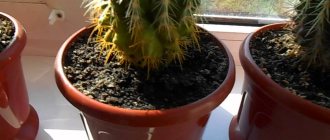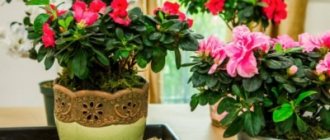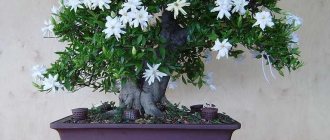Although indoor roses are small, decorative representatives of a garden crop known for its beauty, they can often be seen on the windowsills of experienced gardeners.
This flower allows you to create flower arrangements at home that are no less attractive than in the outdoor garden. Dear readers!
For you, we have created communities on social networks in which useful articles and interesting ideas are published several times a day! Subscribe and receive useful content in a convenient format! However, it is important not to forget that an indoor rose planted in a pot has a reputation as a rather demanding and fastidious plant to care for. It needs to be looked after competently, sensitively and in a timely manner - this is the only way to grow the real pride of a gardener on a windowsill or in a home greenhouse.
How to choose a flower in a store
Firstly, the basis of the correct choice of any indoor plant is its appearance . If an ornamental rose is sold in a pot (temporary or permanent), then it is important to inspect its leaves and shoots.
Indoor rose in store pots
Black dots on the back or outside are a sign of fungal diseases. Small white spots may be a sign of active development of powdery mildew. If dark or dry spots are noticed closer to the root collar, then this is one of the signs of putrefactive or fungal processes in the soil and on the roots.
It is BEST when the rose has dense leaves with a clear shine. Also a good sign of a healthy indoor plant is the presence of young shoots. Then you can be sure that the flower was well looked after and the conditions for it were ideal.
Finally, the rule is that it is preferable to purchase an indoor rose with fewer buds. The more flowers there are on a plant, the faster it will bloom, and the next period of budding will have to wait until the next season.
Well, yellowed, drooping leaves are a sure sign that the indoor rose lacks moisture and nutrients. You can make up for this yourself at home, but a rose in a pot will take time to get into shape.
Main types
Indoor mint: home care and methods of propagation
There are no special varieties intended for growing only at home. Usually for this purpose they take ordinary roses with small sizes, which are grown in open ground.
The classic indoor rose is a low bush or small tree with flowers of different shades: from white, cream and yellow to pink and scarlet, with lanceolate-shaped leaves with teeth along the edge.
Tea, small polyanthus, miniature, Bengal roses and container hybrids are most suitable for these purposes.
Tea rose is an ideal option for indoor growing. It was bred as a mix of several varieties of Bengal roses. Most of its varieties were created specifically as indoor flowers. The bushes look decorative, with dense green foliage, the flowers are delicate and fragrant.
The Chinese rose is valued for its decorative value - small flowers completely cover the bush.
Bengal roses were the first to appear in Europe as the only flowering variety. They do not need pruning or special care; they only do sanitary pruning. They branch well and do not stretch in height. The advantages of these roses are their long flowering and compact bush; some of them have no scent at all.
Indoor rose in the form of a tree
Polyantha roses are indoor varieties created by crossing branching roses. The bush reaches an average height of 50 cm, is branched and dense. Some varieties have flowers collected in brushes; there are double and semi-double varieties. These roses feel great not only in the apartment, but also on balconies.
Bushes of miniature roses are more compact, the flowers are often single or form inflorescences of several pieces.
Advice. When choosing a rose to grow at home, you should take into account the presence and intensity of the aroma, since not everyone can tolerate strong odors, which cause allergies and headaches in some people.
A wide variety of species and varieties allows you to choose a flower to suit your taste.
Features of home care after purchase
IMPORTANT POINT: the favorable time for transplanting an indoor rose is March. But, of course, if the plant is purchased at another time and it is clear that replanting is necessary, then you should not wait specifically for the beginning of spring.
As a rule, on average, indoor roses at the time of sale are still very young bushes, 1-3 months old. In this case, they will definitely experience stress during the next transplant.
On the other hand, the most correct tactic is to wait. You should not replant the rose immediately after purchasing it and moving it to a new place. Firstly, it will help the plant adapt to a new place. Secondly, it will allow you to determine whether the plant has diseases or pests (within 1-2 weeks, possible problems will definitely make themselves felt). And you can replant the rose without fear immediately after this incubation period.
It is known that indoor roses have a very difficult time surviving new growing and caring conditions. During the first 2-3 weeks, the bush can shed not only buds and ovaries, but even leaves. However, this does not mean that the plant dies. You just need to wait for acclimatization and actively care for the new flower.
NOTE: immediately after purchasing a potted rose, you can water it in the bathroom with a warm shower. This will definitely help get rid of spider mites if they are found on the bush.
It is also advisable to wait until most of the flowers, if any, have faded. Only after this should the transplant begin.
Soil for decorative roses: a mixture of turf, humus, peat and sand (4:2:2:1) . Be sure to line the bottom of the pot with 1-3 cm of drainage made of expanded clay or small stone.
Special primer
It is possible (and even advisable) to prune a rose bush before replanting. For future growth, it is enough to leave 3-5 buds on each shoot. The best method of replanting is transferring with the lump of earth that was in the pot.
It is advisable to choose a new pot according to the following principles:
- Must be larger than the old one by at least 2 cm in diameter.
- You can focus on the height of the bush - whatever the height, that’s how the pot should be.
- Future watering tactics depend on the choice of pot material. In plastic containers, soil dries faster and the material is less reliable. Clay dishes also absorb some of the moisture.
In a new pot, the rose will need growth stimulants (Zircon or similar). Moreover, you may even need two treatments one after another with a short break of 3-5 days between them.
In the future, the bushes need to be replanted every 1-2 years, as they grow.
Choosing a pot
The best container for planting roses is considered to be a tall, thick-walled ceramic pot with large holes for drainage. Each subsequent flowerpot should be larger than the previous one - by 4 –
5 cm deep and 2
-
3 cm wide to give the plant room in the pot. It is better to choose the color of the container as light as possible so that the roots of the rose do not overheat. However, if the pot has already been purchased in a dark color, you can wrap it in light paper. You can also simply place a dark flowerpot in a lighter one.
Growing conditions
Flowering roses
After purchasing and replanting a bush rose, all that remains is to get acquainted with the requirements and care conditions that should be observed for it. Many well-known indoor varieties are quite whimsical. They are critical of the temperature range, do not tolerate excessive dryness, but also high humidity, and do not survive drafts and direct sun well.
This is important to take into account if you want to see neat, beautiful, sophisticated bushes of indoor roses at home.
Temperature
Of course, the indoor rose and its numerous hybrids are heat-loving plants . They tolerate heat well, but a moderate regime when caring for them is optimal:
- In summer, it is optimal to maintain a range of +20-25С.
- In winter, it is advisable to stick to +15С, but not allow it to fall below +10С.
Roses are heat-loving plants.
It can be immediately noted that the domestic rose will withstand a short-term increase in temperature. On the other hand, if the bush blooms, then the duration of flowering directly depends on the air temperature. The cooler it is, the more fragrant and long-lasting buds can be seen on the rose almost all summer.
Air humidity
Dry air is a common cause of most rose problems . Starting with withering foliage, falling buds, ending with the appearance of spider mites and some other pests.
Maintain moist air by regularly watering the soil (from 3 times a week in summer, 1 time a week in autumn and winter), installing a special saucer with water under the pot, and spraying the bush. In particularly hot weather, roses can be watered even twice a day - morning and evening. The main thing is not to flood the plant, but to add moisture only when the soil has dried 4-5 cm deep.
It is IMPORTANT to spray the bush during the flowering period, trying to get it on the leaves, stem, top layer of soil, but not on the flower petals. If drops of water get on them, you should immediately carefully remove them from the buds.
For watering roses, use only water at room temperature , settled and preferably filtered.
Lighting
The basic rule for growing roses in pots is that they need enough indirect light, but not direct light. That is why the pots should, if necessary, be additionally shaded or covered with other plants.
During the flowering period, bushes need at least 14 hours of daylight. If such a long daylight hours are not typical for the region, then artificial supplementary lighting may be required.
Choosing a place to put it
Rose on the windowsill
Since decorative roses do not like overheating, they should be kept on southern or eastern windowsills most of the year.
In summer, it is recommended to move roses in pots to open areas or to summer verandas, if possible. In this case, it will be possible to provide the bushes with enough coolness, and this will improve the condition of the flower and flowering will last longer.
What does it look like in the interior?
Perhaps it will not look untrue that the rose is the most famous flower that is grown to decorate gardens, galleries, greenhouses, and rooms. Therefore, miniature roses are, first of all, wonderful decorations that can enhance any interior and attract a person’s attention.
Of course, a rose in a pot is best suited for classic interiors, antique motifs in the design of rooms, and rich decorations.
Modern minimalism is less focused on the use of different types of indoor flowers, however, even in this case, with careful thought through the interior, you can achieve high-quality, interesting combinations.
Selecting a location
The indoor rose is a freedom-loving plant that prefers space and careful care. Therefore, at home there is no need to install a flower garden with other crops. Miniature mixed rose bushes will feel more at ease on a wide windowsill in pots. After purchase, hanging varieties can be placed near windows on the wall, lowered into flower pots, or placed on flower shelves.
Windows facing south will have a great effect on rapid and high-quality growth, since the rose is quite light-loving. The sun's rays in the mornings and evenings will warm the green leaves of the indoor rose. You need to carefully monitor midday lighting; too bright sun will negatively affect the plant. Protection from extreme heat will be a light curtain on the window frame.
In late autumn and winter, you should move the pot from the windowsill, away from the hot radiator. Dry air at home will harm a fragile flower. Alternatively, you can cover the radiators with a wooden or plastic shield or a damp towel. It’s best to move the bush to another place. It is worth providing proper care for the rose after purchase so that the plant pleases your household with a lush crown and bright buds.
The summer period is an excellent reason to move a flower pot outdoors if you have a balcony or loggia. A country house is also great for this. A good place would be a corner with bright but diffused lighting; intense heat is contraindicated for an indoor flower; a hot soil surface is unacceptable.
Note!
For uniform and beautiful growth, the flower should sometimes be turned to the more illuminated side.
Rules of care at different times of the year
As has been noted more than once, indoor roses are too sensitive to indoor conditions. Therefore, caring for flowers at different times of the year has its own key features that are important to know and observe.
in spring
So, spring is considered the time when the rose is prepared for summer flowering.
To do this, a bush is formed, old or dried shoots are pruned.
At this time of year, it is important not to let the rose suffer from lack of moisture. The plant needs to be watered (up to daily frequency, if it is very hot), and in the evenings the bush must be sprayed with a spray bottle. Also in the spring you should leave the plant where the most indirect light is concentrated.
IT IS NO SECRET that a rose is drawn to the light. In order for the bush to grow in the correct shape, you must not forget to turn it a third or a quarter of a circle from time to time.
Of course, in no case should you deprive the rose of fertilizing in the spring. They should begin with the first heat and alternate: either with organic mixtures or with mineral ones. By the end of spring, the optimal frequency of fertilizing is once every 2-3 weeks.
In May or early summer, it is recommended to move the rose pot to a cool, shady place: to the balcony, veranda, or, if weather permits, to the garden.
In summer
Summer is a time of active flowering and growth. But this does not mean that you can only admire the rose, although caring for it at this time of year is very simple.
First of all, it is not recommended to completely abandon fertilizers. Organic mixtures are the best option throughout the season. Secondly, it is very important to monitor your indoor rose for pests or diseases. If necessary, carry out timely treatment with insecticides or folk remedies (all strictly according to recipes).
Of course, in extreme heat, indoor roses are watered more often. Sometimes up to twice a day.
in autumn
With the onset of autumn, reduce fertilizing to a minimum and gradually reduce the frequency of watering. In mid-autumn, when the plant fades, 1-2 waterings per week will be enough for the rose.
If the plant is taken out of the room, then at the end of summer or beginning of autumn - as weather permits - it is returned to winter on the windowsill or in the room where it stood before.
Just before the onset of winter, prune the rose (most varieties require this), leaving up to 5 buds on the shoots.
Autumn pruning of roses
in winter
There are no serious rules for caring for roses in winter, since the plant sheds its leaves and is dormant. It is important to water and spray the bush occasionally. After the soil dries, it is recommended to wait 2-3 days, and only then moisten it moderately.
Optimal air temperature for a flower: +15С. That is why it is recommended to leave the pot away from radiators and other heating devices.
Anything less than +10С will be destructive for the rose.
Temperature
After purchase, it is important to provide proper care for an indoor rose growing in a pot. For good maintenance of bushes at home, a room temperature of 20 to 27˚C is ideal. It is also necessary to have fresh air; it is necessary to ventilate the room. The main thing is that the rose should not be exposed to direct air from a window or air conditioner.
Does a rose bloom at home?
Flowering is the main quality for which a rose is valued . Getting a rose to bloom is relatively easy. Another question is how to improve the quality and duration of flowering. There are some truisms for this:
- The cooler the summer, the longer the roses bloom. If the bushes are placed in the shade, where the temperature almost always stays around +20°C, then the roses will delight with flowers most of the summer.
- After watering and spraying, remove all drops from the buds, otherwise they will crumble faster.
- If treatment for pests or diseases is required, it is not recommended to increase the doses prescribed by manufacturers (many people think that, since roses are grown exclusively for decorative purposes, there is no need to save the poison). Otherwise, insecticides will harm the plant too.
- The more abundant the fertilizing, the more optimal the watering, the longer the bushes bloom.
Hibiscus and hibiscus - what's the difference?
You can brew a tea drink from the flowers of the Chinese rose or Chinese hibiscus (lat. Hibiscus rosa-sinensis). But this is not hibiscus!
Hibiscus tea drink is the dried petals and calyxes of flowers of a completely different type of plant of the Hibiscus genus: Sudanese rose or rosella (lat. Hibiscus sabdariffa). It has a number of beneficial properties due to its unique chemical composition. Contains organic acids (citric, malic, tartaric), amino acids, flavonoids, anthocyanins, vitamins C, PP, A, B, pectins, macro- and microelements.
It is used for:
- normalization of the functioning of the gastrointestinal tract;
- strengthening blood vessels, lowering blood pressure and preventing blood clots;
- fight against excess weight.
And just like:
- choleretic and diuretic;
- improves erectile function in men and the cyclicity of menstruation in women;
- antimicrobial and anti-inflammatory, antipyretic;
- cleansing of impurities and toxins;
- anthelmintic.
You should not use hibiscus:
- children under one year old;
- people with gastritis and peptic ulcers;
- having urolithiasis or cholelithiasis;
- hypotensive patients;
- pregnant and lactating women;
- those who are allergic to the components of the tea drink.
Important! It is not recommended to drink hibiscus on an empty stomach (it can cause stomach problems) or at night (it has a tonic effect and can cause problems falling asleep).
To prepare the drink, take a glass or porcelain cup (not metal!). To preserve the beneficial substances as much as possible, you need to use hot water with a temperature of no higher than 80 degrees rather than boiling water. For 1 cup - 1 teaspoon of tea leaves. Leave until it turns bright red or burgundy. The tea drink is ready! Have a pleasant and healthy tea party!
Transfer
It is necessary to replant roses as the bush grows and there is not enough space in the pot. This process is carried out by ordinary transshipment , trying to harm the root system of the flower as little as possible.
The optimal time is early March . However, you can replant a rose in the summer if it very quickly filled the entire space in the pot with roots and noticeably slowed down in growth.
Reproduction
Basically, ornamental roses are propagated by cuttings . By the way, parts of the shoots remaining after annual pruning are suitable for this purpose.
The cuttings should have at least 2-3 buds and preferably several leaves. It is placed in water (it is better if a growth stimulator is diluted there). The first roots appear within 1-2 weeks. After this, the cuttings are planted in loose and nutritious soil, covered with film or a glass jar to create greenhouse conditions.
The first flowering can occur as early as a year after rooting.
Propagation by cuttings
Is pruning necessary?
Pruning roses is a necessary step for almost all hybrid ornamental varieties (there are exceptions). There are several seasons for active pruning:
- Before winter, the bush is pruned almost completely. Only up to 5 buds remain on each shoot. Leaves and buds are shed.
- In early spring it is allowed to form the crown. To do this, wilted shoots and dry leaves are removed.
- in summer . Mainly for decorative purposes. All drying parts are removed, as well as faded buds.
If you do the pruning correctly, the rose bush will always evoke only positive emotions and grow correctly and aesthetically.
Watering
Beginners may have problems with watering indoor roses. Among professionals - rarely.
THE MOST IMPORTANT RULE: focus on your feelings. It is important to water the rose when the soil dries out (if you press your finger on the soil, the soil feels dry). After drying out in the summer, water immediately, in the cold season, after waiting a 2-3 day break.
Thus, a lot depends on the specific conditions in the room. But most often, domestic roses are watered 2-3 times in the summer (every day if it is very hot), and about 1 time a week in the fall and winter.
It is also advisable to prepare the water. Firstly, stand for at least 24 hours. Secondly, water with cool (about +20С), but not cold water.
Useful tips and nuances
A healthy plant can easily be transplanted and, with proper care, can live for a long time at home.
Experienced gardeners have no problems, but beginners should remember, for example, the following:
- Transplantation is possible at any time of the year, but the rose should not bloom. As a last resort, flowers and buds should be carefully removed and then wait at least a week. The optimal time for transplantation is early spring or late summer.
- If the plant looks healthy, its roots protruding from the clod of earth are light brown and not rotten, it is better to replant the rose using the transshipment method. In any other case, get rid of the old soil. But a flower transplanted with bare roots suffers longer; it is kept in partial shade for up to two weeks.
- Admirers of the Lunar calendar advise planning a transplant during the waxing Moon phase.
- If the room is too hot, you can take the pot out onto the balcony in spring and summer.
- Watering with cold water is unacceptable. The optimal time for watering is morning or evening.
- Feeding should not be carried out in cold weather: it is better to plan it on sunny days.
- Roses need fresh air, but strong drafts are harmful when ventilating.
Owners of summer cottages are better off transplanting roses to a flowerbed: there they feel much better than at home, and the owner does not have to rack his brains about how to provide the flower with a low air temperature in winter.
Among indoor flowers, the rose occupies a special place: after all, it is mainly intended for the garden. However, if desired, it can also be grown on a windowsill, transplanted into a suitable pot in a timely manner and according to the rules.
Feeding
Flowering plants spend a lot of energy during the entire flowering period, drawing most of their supply of nutrients from the soil. In the case of roses in pots, for this reason the plants are fed from March to October .
Any complex, universal fertilizers, as well as organic mixtures, are suitable.
In spring, plants are especially responsive to foliar application of fertilizers.
During the period of active growth, roses should be fed every 8-10 days. Alternate organic and complex mixtures.
Fertilizers for roses are needed until the end of flowering. And an important rule of care: at the end of summer and autumn, nitrogen should be completely excluded from the composition of fertilizing.
Soil selection
It is recommended to purchase soil for planting in specialized stores. The soil for roses must be saturated with essential nutrients and have good moisture and air permeability. You can prepare the soil mixture yourself by mixing the necessary ingredients according to one of the recipes below:
- Turf soil, humus and sand in a ratio of 4:4:1.
- For 3 parts of turf soil, take 1 part each of sand, humus, coniferous and leaf soil.
It is recommended to pre-disinfect all components of the soil mixture.
Different varieties (We make a short overview of the most popular varieties)
Varieties of decorative roses can differ greatly from each other. Moreover, this concerns not only the appearance, the height of the bush, the abundance of greenery, but also such an important factor as aroma. It can be rich or barely noticeable.
- “Angela Ripon” is an almost classic rose with soft pink flowers, but smaller in size than garden varieties (flowers up to 4 cm in diameter). When flowering, the variety emits fragrant, persistent aromas. The bushes grow up to 35 cm and do not require pruning when caring.
- ' Yellow Doll ' is one of the oldest hybrids and has a distinct scent when flowering and the bush produces many flowers with a pale yellow tint. The variety has earned popularity due to the abundance of petals in the bud (up to 50 on each flower).
- " Green Ice " . This variety produces white flowers with a clearly visible green tint. The flowers do not smell strongly, but the most important features of the variety are tall bushes of regular shape (up to 60 cm), extreme resistance to diseases.
Diseases and pests
The sensitivity of an ornamental rose is expressed in the fact that it gets sick or is attacked by pests at the slightest deviation from normal conditions around it. Most often, problems come from too dry air, excessive soil moisture, or insufficient fertilizing .
- Spot is a fungus that appears on the leaves, less often on the stem. It usually occurs due to excess moisture.
- Powdery mildew is another popular disease for indoor roses. On the contrary, it appears due to dry air in the room.
- Spider mites are a pest that reproduces in very dry air.
Not all diseases of ornamental roses can be easily eliminated. However, some techniques exist.
Diseases and pests
Preparing for winter
This is one of the most important stages, during which many conditions must be met:
- compliance with the temperature regime from +15 to +17 °C;
- installing a home rose in a place where the air is not too dry;
- protecting the plant from electrical household appliances - TV, PC, microwave oven, and so on;
- It is advisable to transfer the plant to a cold window or protect the plant from exposure to hot air from the apartment (between frames or behind a special layer of plastic film).
How to resuscitate?
One of the biggest problems with indoor roses is spider mite damage. They get rid of it either by increasing the humidity (including frequent bathing of the bush in the shower) or with a “ Fitoverma ” solution (2-3 treatments will be required with a break of a week between them).
A regular soap solution helps against aphids and other pests (it is preferable to use laundry soap).
If the leaves are affected by fungus, then they need to be plucked. Treat healthy leaves or the entire bush with “ Fitospirin ” or similar fungicidal agents.
If the plant suddenly begins to wither and dry out, it means that it does not have enough watering. Dried parts must be removed immediately and the rose placed in a tray with water. At first, spray the entire bush more often.
Homemade rose began to dry
In summer, the rose begins to dry out due to insufficient watering. In hot weather, the soil dries out quickly, causing the rose's root system to overheat. And therefore the flower begins to dry. At this time of year, the soil should not be allowed to dry out completely, and in the hottest weather, the plant must be sprayed with water several times a day.
During the winter months, the rose also dries out from lack of moisture due to the heating systems in the house, which greatly dries out the air. The problem can be solved by placing the pot in a tray with wet expanded clay, moving it away from the radiators and spraying it. The room must be ventilated regularly. However, drafts should not be allowed.
On a note!
Sometimes the plant may begin to dry out due to rotting roots. This can be detected by removing the rose from the pot and examining its root system. If the roots are dry, brittle or even blackened, then the plant is unlikely to be saved.
Knowing what kind of care is required for roses grown in pots at home, it is worth carrying out the necessary procedures after purchasing them and taking into account all the nuances.
Common mistakes
Knowing that roses are very demanding to care for, it is logical to assume that there may be plenty of mistakes when growing them. However, some of them are the most common:
- Wrong location (a place that is too sunny or too dark will not work).
- Suboptimal irrigation tactics (it is necessary to monitor the condition of the soil, and not develop a standard frequency).
- Lack of fertilizing (roses spend a lot of energy on flowering).
- No pruning (the bush will become ugly and will bloom less).
- Enhanced treatment against pests and diseases, mistakenly assuming that since the plant does not bear fruit, it can be poisoned more abundantly.
Answers to popular questions
After the purchase, the rose dropped all its buds and leaves.
A very common situation that occurs mainly due to the acclimatization of the rose. There is nothing wrong with this process. Unless the plant blooms next time soon (perhaps only next season).
When should you water a flower?
There's a big problem with this. Often people are looking for a certain periodicity, a kind of rule, but it is best to feel the soil (or poke it with a small wooden stick). If the soil does not stick, then it is time to water the soil.
Where is the best place to place the pot?
If the pot will be placed indoors, it is better to leave it on the southern or eastern windowsills. In the summer, it is advisable to try to take the rose out into the fresh air and leave it in a shady, cool place for the entire season.
Why did yellow stripes appear on the leaves?
Perhaps the bush is affected by bacterial cancer. In this case, it is almost impossible to save the plant. It will have to be dug up and destroyed (burned).
How to replant an ornamental rose
It is worth replanting the queen of flowers to a permanent place only when she has fully recovered. According to the lunar calendar, this is best done when the moon is in its waxing phase. Transplantation must be done very carefully so that not a single main root shoot is damaged. It is advisable not to disturb the earthen ball in which the roots are located.
The earthen lump is only slightly loosened along the outer layer, and a small amount of old earth is also removed. If there are a few fertilizer granules on the coma, then there is no need to remove them.
Next, you should prepare nutritious soil for transplanting the rose into a new container. This can be the following mixture: turf soil, humus soil and sand (4:4:1). A small amount of complex fertilizer is mixed into the soil. If you don’t have the opportunity to prepare the correct soil for planting, then you can always buy universal soil for indoor plants or specifically for roses.
Bush rose pot
Further correct cultivation of a home rose requires purchasing the right pot that will suit all parameters. How to choose it?
So, the new pot should be larger than the container, a few centimeters in diameter and about 5–7 cm in height. But remember: it shouldn’t be too big either.
Preparing a flower pot
If something has been grown in a pot before, it should be thoroughly washed under warm water using a stiff brush, but without detergents. If the pot is completely new and ceramic, it should be soaked for several hours in warm water.
Before planting, you must properly “equip the new home” of your indoor rose:
- make drainage from expanded clay,
- make sure there is a drain hole,
- pour the prepared soil with fertilizers into the pot and sprinkle it with a layer of clean soil.
Next, you need to remove the plant from the old pot. To do this, you need to water it generously, let it soak for half an hour, turn the pot over and carefully remove a bush with a dense earthen lump from it.
Now place it in a new pot, gradually sprinkle the prepared soil around the edges and compact it as it shrinks. After transshipment, the rose should be placed in the shade, or even on a north window.
After a day has passed since transplantation, the flower is placed on a well-lit balcony or window sill, moved away from drafts and direct exposure to hot sunlight, and provided with constant access to fresh air.
Conclusion
On the one hand, it may seem that opinions about indoor roses are completely true - caring for the plant is difficult, it reacts to the slightest unfavorable factors.
However, another opinion is also relevant. If you follow the necessary care conditions (and although there are many of them, they are doable), then a decorative rose will absolutely become a worthy decoration for a flower lover’s garden or room; it will bloom for a long time, abundantly and with high quality, delight the eye and bring pride in the work done every year.











